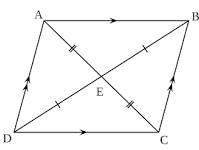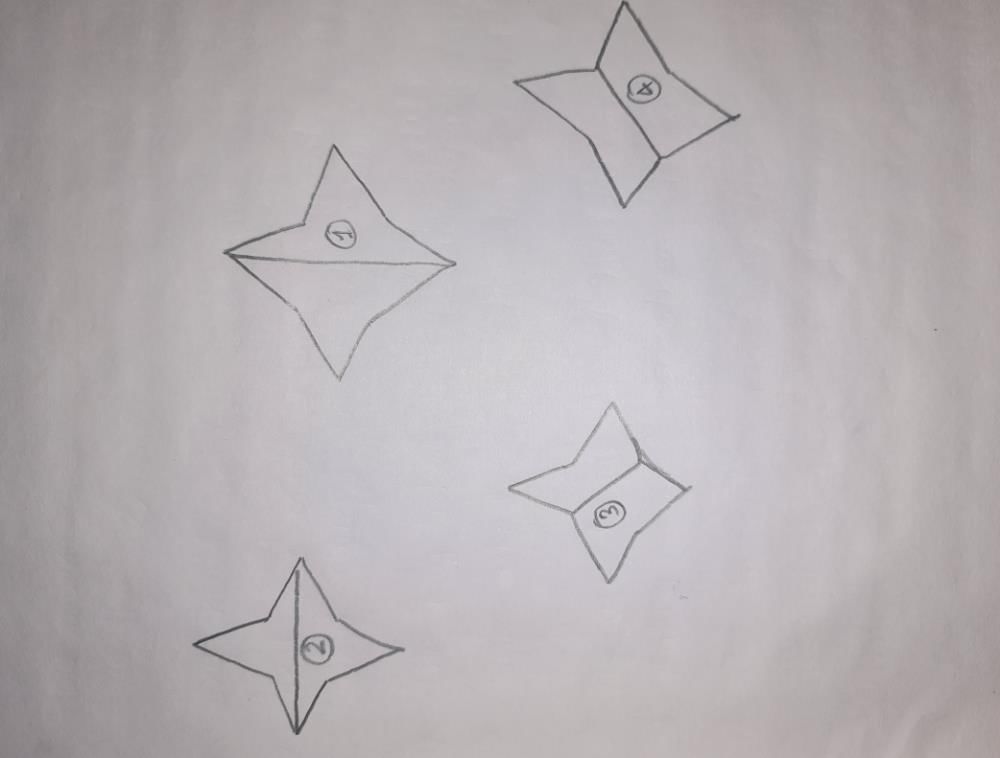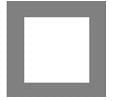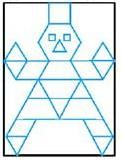All Exams >
CTET & State TET >
Mathematics & Pedagogy Paper 2 for CTET & TET Exams >
All Questions
All questions of Symmetry for CTET & State TET Exam
Q. How many lines of symmetries are there in an isosceles triangle ?a)2b)1c)3d)None of theseCorrect answer is option 'B'. Can you explain this answer?

|
Kunal Mehta answered |
The answer is c.An equilateral triangle, which has... more three equal sides, has three
Which of the following alphabets has line symmetry?- a)A
- b)Q
- c)P
- d)Z
Correct answer is option 'A'. Can you explain this answer?
Which of the following alphabets has line symmetry?
a)
A
b)
Q
c)
P
d)
Z
|
|
Utkarsh Joshi answered |
If you draw a line between A you see both the sides equal.
How many lines of symmetries are there in an equilateral triangle?- a)0
- b)2
- c)3
- d)1
Correct answer is option 'C'. Can you explain this answer?
How many lines of symmetries are there in an equilateral triangle?
a)
0
b)
2
c)
3
d)
1

|
Gayatri Chavan answered |
The division of triangles into scalene, isosceles, and equilateral can be thought of in terms of lines of symmetry. A scalene triangle is a triangle with no lines of symmetry while an isosceles triangle has at least one line of symmetry and an equilateral triangle has three lines of symmetry.
In a Δ ABC, AB = AC and AD⊥BC, BE⊥ AC and CF ⊥ AB. Then about which of the following is the triangle symmetrical?
- a)AD
- b)BE
- c)CF
- d)AC
Correct answer is option 'A'. Can you explain this answer?
In a Δ ABC, AB = AC and AD⊥BC, BE⊥ AC and CF ⊥ AB. Then about which of the following is the triangle symmetrical?
a)
AD
b)
BE
c)
CF
d)
AC
|
|
Nilotpal Nambiar answered |
It is crucial to ensure that AI is developed and used in a responsible and ethical manner to benefit society as a whole. This involves creating guidelines and regulations that prioritize safety, privacy, and fairness. The future of AI is exciting, but it is essential to approach it with caution and responsibility.
Can you explain the answer of this question below:How many lines of symmetries are there in rectangle?
- A:
4
- B:
0
- C:
1
- D:
None of these
The answer is a.
How many lines of symmetries are there in rectangle?
4
0
1
None of these

|
Arjun Desai answered |
Four lines
The square has four lines of symmetry. The rectangle has only two, as it can be folded in half horizontally or vertically: students should be encouraged to try to fold the rectangle in half diagonally to see why this does not work.
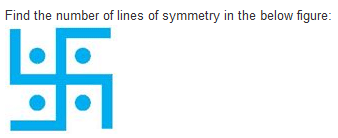
- a)4
- b)3
- c)2
- d)None of these
Correct answer is option 'C'. Can you explain this answer?
a)
4
b)
3
c)
2
d)
None of these

|
A1 Sports answered |
Because it has vertical line of symmetry and horizontal line of symmetry.
The order of the rotational symmetry of the parallelogram about the centre is- a)1
- b)0
- c)3
- d)2
Correct answer is option 'B'. Can you explain this answer?
The order of the rotational symmetry of the parallelogram about the centre is
a)
1
b)
0
c)
3
d)
2
|
|
Amit Sharma answered |
A general parallelogram has no lines of symmetry.
The mirror image of ‘W’, when the mirror is placed vertically:- a)U
- b)M
- c)V
- d)W
Correct answer is option 'D'. Can you explain this answer?
The mirror image of ‘W’, when the mirror is placed vertically:
a)
U
b)
M
c)
V
d)
W
|
|
Priyanka Sharma answered |
In case of standard form of mirror image i.e., when the mirror is placed vertically, the object gets laterally inverted. In order words, the Left Hand Side (LHS) and Right Hand Side (RHS) of an object interchange their places while top and button remain the same.
How many lines of symmetries are there in a rhombus?a)1b)2c)3d)4Correct answer is option 'B'. Can you explain this answer?

|
Swara Mukherjee answered |
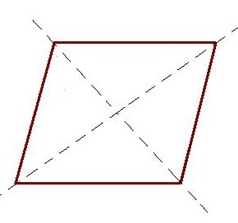
Lines of symmetry in a rhombus = 2
A rhombus has two lines of symmetry that run through one vertex to the one directly across it. Unlike a square, planes through the center of each edge of a rhombus do not yield mirrored sides.
How many lines of symmetries are there in regular pentagon?
- a)3
- b)5
- c)2
- d)4
Correct answer is option 'B'. Can you explain this answer?
How many lines of symmetries are there in regular pentagon?
a)
3
b)
5
c)
2
d)
4

|
Harshitha Mukherjee answered |
A regular pentagon has 5 sides and 5 lines of symmetry. The number of lines of symmetry in a regular polygon is equal to the number of sides. There are 5 lines of symmetry in a regular pentagon.
How many lines of symmetries are there in a square?- a)1
- b)2
- c)4
- d)3
Correct answer is option 'C'. Can you explain this answer?
How many lines of symmetries are there in a square?
a)
1
b)
2
c)
4
d)
3
|
|
Amit Sharma answered |
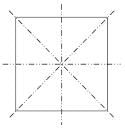
For the square, it can be folded in half over either diagonal, the horizontal segment which cuts the square in half, or the vertical segment which cuts the square in half. So the square has four lines of symmetry.
Find the number of lines of symmetry in the below figure: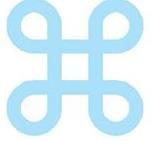
- a)1
- b)4
- c)2
- d)3
Correct answer is option 'B'. Can you explain this answer?
Find the number of lines of symmetry in the below figure:

a)
1
b)
4
c)
2
d)
3

|
Anushka Debta answered |
Two lines are horizontal and two are vertical from its turnings
Find the number of lines of symmetry of the figure given.

- a)6
- b)1
- c)4
- d)8
Correct answer is option 'A'. Can you explain this answer?
Find the number of lines of symmetry of the figure given.


a)
6
b)
1
c)
4
d)
8
|
|
Riya Jain answered |
Yes the correct answer is option a
Letter ‘D’ of the English alphabet have reflectional symmetry (i.e., symmetry related to mirror reflection) about.- a)a vertical mirror
- b)both
- c)a horizontal mirror
- d)None of these
Correct answer is option 'A'. Can you explain this answer?
Letter ‘D’ of the English alphabet have reflectional symmetry (i.e., symmetry related to mirror reflection) about.
a)
a vertical mirror
b)
both
c)
a horizontal mirror
d)
None of these
|
|
Varun Jain answered |
Dear [Recipient],
I hope this letter finds you well. I am writing to express my gratitude for all the help and support you have provided me over the past few months. Your kindness and generosity have been a great source of comfort and strength during a difficult time in my life.
I want you to know that I appreciate everything you have done for me. Your unwavering support and encouragement have helped me to stay positive and motivated. Your words of wisdom and guidance have helped me to make important decisions and navigate through challenging situations.
I am truly grateful for the time and effort you have invested in me. Your willingness to lend a listening ear, offer advice, and provide a shoulder to cry on has meant the world to me. I will always remember your kindness and the impact you have had on my life.
Once again, thank you for everything. I am blessed to have you in my life, and I look forward to continuing to nurture our friendship in the years to come.
Sincerely,
[Your Name]
I hope this letter finds you well. I am writing to express my gratitude for all the help and support you have provided me over the past few months. Your kindness and generosity have been a great source of comfort and strength during a difficult time in my life.
I want you to know that I appreciate everything you have done for me. Your unwavering support and encouragement have helped me to stay positive and motivated. Your words of wisdom and guidance have helped me to make important decisions and navigate through challenging situations.
I am truly grateful for the time and effort you have invested in me. Your willingness to lend a listening ear, offer advice, and provide a shoulder to cry on has meant the world to me. I will always remember your kindness and the impact you have had on my life.
Once again, thank you for everything. I am blessed to have you in my life, and I look forward to continuing to nurture our friendship in the years to come.
Sincerely,
[Your Name]
Letter ‘H’ of the English alphabet have reflectional symmetry (i.e., symmetry related to mirror reflection) about.- a)Neither horizontal nor veritcal
- b)Both horizontal nor veritcal
- c)a horizontal mirror
- d)a vertical mirror
Correct answer is option 'B'. Can you explain this answer?
Letter ‘H’ of the English alphabet have reflectional symmetry (i.e., symmetry related to mirror reflection) about.
a)
Neither horizontal nor veritcal
b)
Both horizontal nor veritcal
c)
a horizontal mirror
d)
a vertical mirror
|
|
Sanjaycharan Bandaru answered |
B
Which of the following figures are symmetrical with respect to exactly two lines?
- a)

- b)

- c)

- d)

Correct answer is option 'C'. Can you explain this answer?
Which of the following figures are symmetrical with respect to exactly two lines?
a)

b)

c)

d)

|
|
Hansraj Bhadane answered |
Answer is C because they had said exactly 2 line of symentry option a has 4 lines of symentry so it will not the answer option b has only 1 line of symentry so it will also not come option d has 4 lines of symentry so it will not also come but option c has exactly 2 lines of symentry so it will be answer
Which of the following alphabets has no line of symmetry?- a)A
- b)B
- c)Q
- d)O
Correct answer is option 'C'. Can you explain this answer?
Which of the following alphabets has no line of symmetry?
a)
A
b)
B
c)
Q
d)
O
|
|
Varun Jain answered |
Explanation:
A line of symmetry is a line that divides a shape into two identical halves. If a shape has a line of symmetry, it means that one half of the shape can be reflected or folded over the line to match the other half exactly.
In this case, we need to determine which alphabet out of A, B, Q, and O does not have a line of symmetry.
A:
The alphabet A has a vertical line of symmetry. It can be folded in half along the line passing through the middle to form two identical halves.
B:
The alphabet B has a vertical line of symmetry. It can be folded in half along the line passing through the middle to form two identical halves.
Q:
The alphabet Q does not have a line of symmetry. If we try to fold it along any vertical or horizontal line, the two halves will not match exactly. The tail of the Q makes it asymmetrical.
O:
The alphabet O has a vertical line of symmetry. It can be folded in half along the line passing through the middle to form two identical halves.
Therefore, out of the given options, the alphabet Q does not have a line of symmetry.
A line of symmetry is a line that divides a shape into two identical halves. If a shape has a line of symmetry, it means that one half of the shape can be reflected or folded over the line to match the other half exactly.
In this case, we need to determine which alphabet out of A, B, Q, and O does not have a line of symmetry.
A:
The alphabet A has a vertical line of symmetry. It can be folded in half along the line passing through the middle to form two identical halves.
B:
The alphabet B has a vertical line of symmetry. It can be folded in half along the line passing through the middle to form two identical halves.
Q:
The alphabet Q does not have a line of symmetry. If we try to fold it along any vertical or horizontal line, the two halves will not match exactly. The tail of the Q makes it asymmetrical.
O:
The alphabet O has a vertical line of symmetry. It can be folded in half along the line passing through the middle to form two identical halves.
Therefore, out of the given options, the alphabet Q does not have a line of symmetry.
How many lines of symmetry does a rectangle have?
- a)One
- b)Two
- c)Three
- d)Many
Correct answer is option 'B'. Can you explain this answer?
How many lines of symmetry does a rectangle have?
a)
One
b)
Two
c)
Three
d)
Many
|
|
Priyanka Mukherjee answered |
**Explanation:**
A rectangle is a four-sided polygon with opposite sides that are equal in length and four right angles. It is a special type of parallelogram. One of the key features of a rectangle is that it has two pairs of parallel sides.
**Lines of Symmetry:**
A line of symmetry is a line that divides an object into two congruent halves that are mirror images of each other. In other words, if you were to fold the object along the line of symmetry, both halves would perfectly overlap.
**Symmetry in a Rectangle:**
To determine the number of lines of symmetry in a rectangle, we need to examine its properties.
1. **Vertical Line of Symmetry:**
- A rectangle has one vertical line of symmetry that divides it into two congruent halves.
- If you were to fold the rectangle along the vertical line of symmetry, both halves would overlap perfectly.
2. **Horizontal Line of Symmetry:**
- Similarly, a rectangle also has one horizontal line of symmetry that divides it into two congruent halves.
- Folding the rectangle along the horizontal line of symmetry would result in perfect overlap of both halves.
3. **Combining Vertical and Horizontal Symmetry:**
- When the vertical and horizontal lines of symmetry are combined, they intersect at the center of the rectangle.
- This point is the point of symmetry for both lines.
4. **Diagonal Lines of Symmetry:**
- A rectangle does not have any diagonal lines of symmetry.
- Folding the rectangle along any diagonal line would not result in perfect overlap of the halves.
Therefore, a rectangle has a total of **two lines of symmetry** - one vertical and one horizontal. These lines divide the rectangle into four congruent quadrants.
A rectangle is a four-sided polygon with opposite sides that are equal in length and four right angles. It is a special type of parallelogram. One of the key features of a rectangle is that it has two pairs of parallel sides.
**Lines of Symmetry:**
A line of symmetry is a line that divides an object into two congruent halves that are mirror images of each other. In other words, if you were to fold the object along the line of symmetry, both halves would perfectly overlap.
**Symmetry in a Rectangle:**
To determine the number of lines of symmetry in a rectangle, we need to examine its properties.
1. **Vertical Line of Symmetry:**
- A rectangle has one vertical line of symmetry that divides it into two congruent halves.
- If you were to fold the rectangle along the vertical line of symmetry, both halves would overlap perfectly.
2. **Horizontal Line of Symmetry:**
- Similarly, a rectangle also has one horizontal line of symmetry that divides it into two congruent halves.
- Folding the rectangle along the horizontal line of symmetry would result in perfect overlap of both halves.
3. **Combining Vertical and Horizontal Symmetry:**
- When the vertical and horizontal lines of symmetry are combined, they intersect at the center of the rectangle.
- This point is the point of symmetry for both lines.
4. **Diagonal Lines of Symmetry:**
- A rectangle does not have any diagonal lines of symmetry.
- Folding the rectangle along any diagonal line would not result in perfect overlap of the halves.
Therefore, a rectangle has a total of **two lines of symmetry** - one vertical and one horizontal. These lines divide the rectangle into four congruent quadrants.
Which of the following has 5 lines of symmetry?- a)A circle.
- b)A regular pentagon.
- c)A triangle.
- d)A quadrilateral.
Correct answer is option 'B'. Can you explain this answer?
Which of the following has 5 lines of symmetry?
a)
A circle.
b)
A regular pentagon.
c)
A triangle.
d)
A quadrilateral.

|
Rishika Chopra answered |
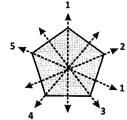
A regular pentagon has 5 equal sides. So the line passing through each vertex to the each opposite side will be a line of symmetry.
Letter ‘I’ of the English alphabet have reflectional symmetry (i.e., symmetry related to mirror reflection) about.
- a)Neither horizontal nor veritcal
- b)a horizontal mirror
- c)Both horizontal and veritcal
- d)a vertical mirror
Correct answer is option 'C'. Can you explain this answer?
Letter ‘I’ of the English alphabet have reflectional symmetry (i.e., symmetry related to mirror reflection) about.
a)
Neither horizontal nor veritcal
b)
a horizontal mirror
c)
Both horizontal and veritcal
d)
a vertical mirror

|
Siddharth Chavan answered |
(a) Vertical mirror – A, H, I, M, O, T, U, V, W, X and Y(b) Horizontal mirror – B, C, D, E, H, I, O and X(c) Both horizontal and vertical mirror – H, I, O and X
The number of lines of symmetry a rectangle does have:- a)1
- b)2
- c)3
- d)0
Correct answer is option 'B'. Can you explain this answer?
The number of lines of symmetry a rectangle does have:
a)
1
b)
2
c)
3
d)
0
|
|
Geetika Shah answered |
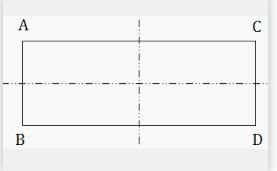
Rectangle have 2 lines of symmetry
What is the other name for a line of symmetry of a circle?- a) An arc
- b)A diameter
- c) A sector
- d)A radius
Correct answer is option 'B'. Can you explain this answer?
What is the other name for a line of symmetry of a circle?
a)
An arc
b)
A diameter
c)
A sector
d)
A radius
|
|
Kalyan Sengupta answered |
A diameter divides the circle into 2 equal parts. So, it can be considered as a line of symmetry.
ABCD is a kite in which AB = AD and BC = DC. Which of the following is the kite symmetrical about?

- a)The diagonal AC.
- b)The diagonal BD.
- c)The point O.
- d)The side BC.
Correct answer is option 'A'. Can you explain this answer?
ABCD is a kite in which AB = AD and BC = DC. Which of the following is the kite symmetrical about?


a)
The diagonal AC.
b)
The diagonal BD.
c)
The point O.
d)
The side BC.

|
Shikha Joshi answered |
It is symmetrical about the o point because all the lines passing through it plese go through the symmetry chapter again
Which of the following alphabets has many lines of symmetry?- a)A
- b)O
- c)Q
- d)B
Correct answer is option 'B'. Can you explain this answer?
Which of the following alphabets has many lines of symmetry?
a)
A
b)
O
c)
Q
d)
B
|
|
Pritam Kulkarni answered |
Explanation:
- Line of symmetry is an imaginary line that divides a shape into two identical parts.
- A shape can have multiple lines of symmetry depending on its symmetry.
- Alphabets can also have lines of symmetry.
- The alphabets that have many lines of symmetry are those that have a high degree of symmetry.
- Out of the given options, the alphabet 'O' has many lines of symmetry.
- Let's see why:
- The alphabet 'O' is a circular shape.
- A circle has an infinite number of lines of symmetry because it can be divided into two identical parts from any point on its circumference.
- Thus, the alphabet 'O' has many lines of symmetry.
- On the other hand, the alphabets 'A', 'Q', and 'B' have fewer lines of symmetry because they have a lower degree of symmetry than the letter 'O'.
- The alphabet 'A' has only one line of symmetry, which divides it into two identical parts vertically.
- The alphabet 'Q' has one line of symmetry, which divides it into two identical parts vertically.
- The alphabet 'B' has two lines of symmetry, which divide it into two identical parts horizontally and vertically.
A rhombus is symmetrical about- a)the line joining the midpoints of its adjacent sides.
- b)each of its diagonals.
- c)perpendicular bisector of each of its sides.
- d)its sides.
Correct answer is option 'B'. Can you explain this answer?
A rhombus is symmetrical about
a)
the line joining the midpoints of its adjacent sides.
b)
each of its diagonals.
c)
perpendicular bisector of each of its sides.
d)
its sides.
|
|
Ashwin Chauhan answered |
Rhombus Symmetry:
A rhombus is a quadrilateral with four sides of equal length. It is a special type of parallelogram where opposite sides are parallel and opposite angles are equal. In addition to these properties, a rhombus also has symmetry.
Symmetry:
Symmetry refers to an object's ability to have one or more lines or planes of symmetry. A line of symmetry divides an object into two equal halves that are mirror images of each other. In the case of a rhombus, it has two lines of symmetry that pass through its diagonals.
Lines of Symmetry:
The lines of symmetry in a rhombus are formed by its diagonals. A diagonal is a line segment connecting any two non-adjacent vertices of the rhombus. Since a rhombus has equal sides, its diagonals bisect each other at right angles. The point of intersection of the diagonals is the rhombus' center.
Symmetry about Diagonals:
When we say a rhombus is symmetrical about its diagonals, it means that if we fold the rhombus along any of its diagonals, the two halves will perfectly overlap each other. This is because the diagonals divide the rhombus into two congruent triangles. The line of symmetry is the diagonal itself.
Symmetry about Other Lines:
While a rhombus has other lines of symmetry, such as the line joining the midpoints of its adjacent sides or the perpendicular bisector of each of its sides, these lines do not divide the rhombus into congruent parts. Therefore, the rhombus is not symmetrical about these lines.
Conclusion:
In conclusion, a rhombus is symmetrical about each of its diagonals. Folding a rhombus along any of its diagonals will result in two identical halves. The other lines mentioned, such as the line joining the midpoints of its adjacent sides or the perpendicular bisector of each of its sides, do not divide the rhombus into congruent parts and therefore do not represent lines of symmetry for a rhombus.
A rhombus is a quadrilateral with four sides of equal length. It is a special type of parallelogram where opposite sides are parallel and opposite angles are equal. In addition to these properties, a rhombus also has symmetry.
Symmetry:
Symmetry refers to an object's ability to have one or more lines or planes of symmetry. A line of symmetry divides an object into two equal halves that are mirror images of each other. In the case of a rhombus, it has two lines of symmetry that pass through its diagonals.
Lines of Symmetry:
The lines of symmetry in a rhombus are formed by its diagonals. A diagonal is a line segment connecting any two non-adjacent vertices of the rhombus. Since a rhombus has equal sides, its diagonals bisect each other at right angles. The point of intersection of the diagonals is the rhombus' center.
Symmetry about Diagonals:
When we say a rhombus is symmetrical about its diagonals, it means that if we fold the rhombus along any of its diagonals, the two halves will perfectly overlap each other. This is because the diagonals divide the rhombus into two congruent triangles. The line of symmetry is the diagonal itself.
Symmetry about Other Lines:
While a rhombus has other lines of symmetry, such as the line joining the midpoints of its adjacent sides or the perpendicular bisector of each of its sides, these lines do not divide the rhombus into congruent parts. Therefore, the rhombus is not symmetrical about these lines.
Conclusion:
In conclusion, a rhombus is symmetrical about each of its diagonals. Folding a rhombus along any of its diagonals will result in two identical halves. The other lines mentioned, such as the line joining the midpoints of its adjacent sides or the perpendicular bisector of each of its sides, do not divide the rhombus into congruent parts and therefore do not represent lines of symmetry for a rhombus.
How many lines of symmetry does a circle have?- a)One
- b)Two
- c)Three
- d)Many
Correct answer is option 'D'. Can you explain this answer?
How many lines of symmetry does a circle have?
a)
One
b)
Two
c)
Three
d)
Many

|
Rohini Seth answered |
A circle has many lines of symmetry. It has an infinite number of lines of symmetry. Every diameter of the circle is a line of symmetry.
Thus, the correct answer is Option D: Many.
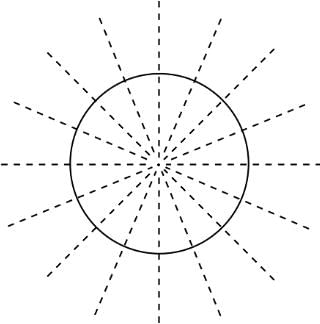

Letter ‘B’ of the English alphabet have reflectional symmetry (i.e., symmetry related to mirror reflection) about.- a)a horizontal mirror
- b)a vertical mirror
- c)both
- d)None of these
Correct answer is option 'A'. Can you explain this answer?
Letter ‘B’ of the English alphabet have reflectional symmetry (i.e., symmetry related to mirror reflection) about.
a)
a horizontal mirror
b)
a vertical mirror
c)
both
d)
None of these
|
|
Moumita Pillai answered |
Understanding Reflectional Symmetry
Reflectional symmetry, also known as mirror symmetry, occurs when an object can be divided into two identical halves that are mirror images of each other.
Symmetry of the Letter 'B'
The letter 'B' has a unique structure that allows it to exhibit reflectional symmetry. Let's analyze its symmetry:
Horizontal Mirror Symmetry
- When the letter 'B' is mirrored along a horizontal axis (imagine a line cutting the letter through the middle horizontally), the top half and the bottom half of 'B' appear as mirror images of each other.
- This means that if you were to fold the letter 'B' along this horizontal line, both halves would align perfectly.
Vertical Mirror Symmetry
- On the other hand, when considering vertical mirror symmetry (a line cutting the letter down the center), the left side and right side of 'B' do not match.
- The left side has a straight vertical line, while the right side has two rounded curves, making them distinctly different. Therefore, there is no vertical symmetry.
Conclusion
- Since the letter 'B' has only horizontal symmetry and not vertical symmetry, the correct answer to the question regarding its reflectional symmetry is option 'A': a horizontal mirror.
- This understanding is essential for recognizing the properties of letters in relation to symmetry, which can be a fascinating aspect of geometry and design.
Reflectional symmetry, also known as mirror symmetry, occurs when an object can be divided into two identical halves that are mirror images of each other.
Symmetry of the Letter 'B'
The letter 'B' has a unique structure that allows it to exhibit reflectional symmetry. Let's analyze its symmetry:
Horizontal Mirror Symmetry
- When the letter 'B' is mirrored along a horizontal axis (imagine a line cutting the letter through the middle horizontally), the top half and the bottom half of 'B' appear as mirror images of each other.
- This means that if you were to fold the letter 'B' along this horizontal line, both halves would align perfectly.
Vertical Mirror Symmetry
- On the other hand, when considering vertical mirror symmetry (a line cutting the letter down the center), the left side and right side of 'B' do not match.
- The left side has a straight vertical line, while the right side has two rounded curves, making them distinctly different. Therefore, there is no vertical symmetry.
Conclusion
- Since the letter 'B' has only horizontal symmetry and not vertical symmetry, the correct answer to the question regarding its reflectional symmetry is option 'A': a horizontal mirror.
- This understanding is essential for recognizing the properties of letters in relation to symmetry, which can be a fascinating aspect of geometry and design.
Letter ‘A’ of the English alphabet have reflectional symmetry (i.e., symmetry related to mirror reflection) about.- a)a horizontal mirror
- b)a vertical mirror
- c)both
- d)None of these
Correct answer is option 'B'. Can you explain this answer?
Letter ‘A’ of the English alphabet have reflectional symmetry (i.e., symmetry related to mirror reflection) about.
a)
a horizontal mirror
b)
a vertical mirror
c)
both
d)
None of these
|
|
Ashwini Chauhan answered |
Dear [Recipient's Name],
I hope this letter finds you in good health and high spirits. I am writing to express my deepest gratitude and appreciation for your support and kindness.
Throughout my life, I have encountered numerous challenges and obstacles, and it is during these times that your unwavering support has truly made a difference. Your encouragement, love, and understanding have been my guiding light, helping me navigate through the darkest of days.
Your belief in me has given me the strength and confidence to pursue my dreams and achieve my goals. Your words of wisdom and advice have been invaluable, guiding me towards making the right decisions and choices in life.
I am truly blessed to have you by my side, as you have always been there for me, cheering me on in both my triumphs and failures. Your unconditional love and unwavering support have been a constant source of inspiration, motivating me to never give up and keep pushing forward.
I want to take this opportunity to thank you for your selflessness and generosity. You have always put my needs before your own, sacrificing your time and resources to ensure my well-being and happiness. Your acts of kindness have touched my heart in more ways than words can express.
I am forever grateful for the love and care you have shown me. Your presence in my life has made it richer, brighter, and filled with joy. You have taught me the true meaning of compassion, empathy, and unconditional love. Your belief in me has given me the courage to believe in myself and reach for the stars.
Thank you for being my rock, my guiding light, and my source of strength. I am eternally grateful for your love and support, and I promise to cherish and honor it for the rest of my life.
With all my love and gratitude,
[Your Name]
I hope this letter finds you in good health and high spirits. I am writing to express my deepest gratitude and appreciation for your support and kindness.
Throughout my life, I have encountered numerous challenges and obstacles, and it is during these times that your unwavering support has truly made a difference. Your encouragement, love, and understanding have been my guiding light, helping me navigate through the darkest of days.
Your belief in me has given me the strength and confidence to pursue my dreams and achieve my goals. Your words of wisdom and advice have been invaluable, guiding me towards making the right decisions and choices in life.
I am truly blessed to have you by my side, as you have always been there for me, cheering me on in both my triumphs and failures. Your unconditional love and unwavering support have been a constant source of inspiration, motivating me to never give up and keep pushing forward.
I want to take this opportunity to thank you for your selflessness and generosity. You have always put my needs before your own, sacrificing your time and resources to ensure my well-being and happiness. Your acts of kindness have touched my heart in more ways than words can express.
I am forever grateful for the love and care you have shown me. Your presence in my life has made it richer, brighter, and filled with joy. You have taught me the true meaning of compassion, empathy, and unconditional love. Your belief in me has given me the courage to believe in myself and reach for the stars.
Thank you for being my rock, my guiding light, and my source of strength. I am eternally grateful for your love and support, and I promise to cherish and honor it for the rest of my life.
With all my love and gratitude,
[Your Name]
Letter ‘M’ of the English alphabet have reflectional symmetry (i.e., symmetry related to mirror reflection) about.- a)a vertical mirror
- b)a horizontal mirror
- c)both
- d)None of these
Correct answer is option 'A'. Can you explain this answer?
Letter ‘M’ of the English alphabet have reflectional symmetry (i.e., symmetry related to mirror reflection) about.
a)
a vertical mirror
b)
a horizontal mirror
c)
both
d)
None of these
|
|
Keerthana Menon answered |
Dear [Recipient],
I am writing this letter to express my sincere gratitude for your support and guidance during my time of need. Your kindness and assistance have been invaluable to me, and I cannot thank you enough.
Your words of encouragement and advice have been a source of inspiration for me, and I have learned so much from you. Your willingness to help me has been a true blessing, and I am truly grateful for all that you have done.
Please accept this letter as a small token of my appreciation. I hope that you will continue to be a positive influence in my life and in the lives of others.
Once again, thank you for everything that you have done for me. Your generosity and compassion have made a world of difference, and I will never forget your kindness.
Sincerely,
[Your Name]
I am writing this letter to express my sincere gratitude for your support and guidance during my time of need. Your kindness and assistance have been invaluable to me, and I cannot thank you enough.
Your words of encouragement and advice have been a source of inspiration for me, and I have learned so much from you. Your willingness to help me has been a true blessing, and I am truly grateful for all that you have done.
Please accept this letter as a small token of my appreciation. I hope that you will continue to be a positive influence in my life and in the lives of others.
Once again, thank you for everything that you have done for me. Your generosity and compassion have made a world of difference, and I will never forget your kindness.
Sincerely,
[Your Name]
The minimum number of squares that must be shaded, so that the figure has a line of symmetry is _________.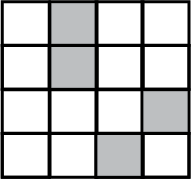
- a)1
- b)2
- c)3
- d)0
Correct answer is option 'A'. Can you explain this answer?
The minimum number of squares that must be shaded, so that the figure has a line of symmetry is _________.

a)
1
b)
2
c)
3
d)
0

|
Get Idea answered |
As shown in the figure only one minimum square should be shaded so that the figure has a line of symmetry.
Hence the correct answer is option A.

Letter ‘T’ of the English alphabet have reflectional symmetry (i.e., symmetry related to mirror reflection) about.- a)a horizontal mirror
- b)both
- c)a vertical mirror
- d)None of these
Correct answer is option 'C'. Can you explain this answer?
Letter ‘T’ of the English alphabet have reflectional symmetry (i.e., symmetry related to mirror reflection) about.
a)
a horizontal mirror
b)
both
c)
a vertical mirror
d)
None of these
|
|
Varun Patel answered |
Understanding Reflectional Symmetry
Reflectional symmetry occurs when a shape can be divided into two identical halves by a line (mirror line). For the letter 'T', we need to analyze its symmetry in relation to vertical and horizontal mirrors.
Vertical Mirror Symmetry
- The letter 'T' can be divided by a vertical line running down the center.
- Both halves (left and right) are mirror images of each other.
- This means that if you were to fold the letter along this vertical line, the two sides would match perfectly.
Horizontal Mirror Symmetry
- When considering a horizontal mirror, the letter 'T' does not exhibit symmetry.
- If you were to draw a horizontal line through the middle of 'T', the top part would not match the bottom part.
- Therefore, 'T' does not have reflectional symmetry in this direction.
Conclusion
- Since the letter 'T' only possesses reflectional symmetry about a vertical mirror and not a horizontal one, the correct answer to the question is option 'C'.
- This understanding emphasizes the importance of recognizing how shapes can be symmetrical in different orientations.
By analyzing the letter 'T' carefully, we conclude that it showcases reflectional symmetry only with a vertical mirror.
Reflectional symmetry occurs when a shape can be divided into two identical halves by a line (mirror line). For the letter 'T', we need to analyze its symmetry in relation to vertical and horizontal mirrors.
Vertical Mirror Symmetry
- The letter 'T' can be divided by a vertical line running down the center.
- Both halves (left and right) are mirror images of each other.
- This means that if you were to fold the letter along this vertical line, the two sides would match perfectly.
Horizontal Mirror Symmetry
- When considering a horizontal mirror, the letter 'T' does not exhibit symmetry.
- If you were to draw a horizontal line through the middle of 'T', the top part would not match the bottom part.
- Therefore, 'T' does not have reflectional symmetry in this direction.
Conclusion
- Since the letter 'T' only possesses reflectional symmetry about a vertical mirror and not a horizontal one, the correct answer to the question is option 'C'.
- This understanding emphasizes the importance of recognizing how shapes can be symmetrical in different orientations.
By analyzing the letter 'T' carefully, we conclude that it showcases reflectional symmetry only with a vertical mirror.
Letter ‘E’ of the English alphabet have reflectional symmetry (i.e., symmetry related to mirror reflection) about.- a)a horizontal mirror
- b)a vertical mirror
- c)both
- d)None of these
Correct answer is option 'A'. Can you explain this answer?
Letter ‘E’ of the English alphabet have reflectional symmetry (i.e., symmetry related to mirror reflection) about.
a)
a horizontal mirror
b)
a vertical mirror
c)
both
d)
None of these

|
Kiran Saha answered |
Horizontal Mirror Symmetry:
Horizontal mirror symmetry means that if you were to place a mirror horizontally through the center of the letter 'E', the reflection in the mirror would be identical to the original letter. In the case of the letter 'E', when you draw a horizontal line through its center, the top part of the letter reflects as the bottom part, creating a symmetrical image.
Vertical Mirror Symmetry:
Vertical mirror symmetry involves placing a mirror vertically through the center of the letter. If the letter 'E' had vertical mirror symmetry, the left side would be a mirror image of the right side when reflected in the mirror. However, in the case of the letter 'E', it does not have vertical mirror symmetry.
Combination of Symmetry:
When considering the symmetry of the letter 'E', it only exhibits horizontal mirror symmetry. This means that the letter 'E' has reflectional symmetry about a horizontal mirror but not a vertical mirror. The top and bottom halves of the letter 'E' are mirror images of each other when reflected in a horizontal mirror.
Therefore, the correct answer is option 'A', which states that the letter 'E' has reflectional symmetry about a horizontal mirror.
Horizontal mirror symmetry means that if you were to place a mirror horizontally through the center of the letter 'E', the reflection in the mirror would be identical to the original letter. In the case of the letter 'E', when you draw a horizontal line through its center, the top part of the letter reflects as the bottom part, creating a symmetrical image.
Vertical Mirror Symmetry:
Vertical mirror symmetry involves placing a mirror vertically through the center of the letter. If the letter 'E' had vertical mirror symmetry, the left side would be a mirror image of the right side when reflected in the mirror. However, in the case of the letter 'E', it does not have vertical mirror symmetry.
Combination of Symmetry:
When considering the symmetry of the letter 'E', it only exhibits horizontal mirror symmetry. This means that the letter 'E' has reflectional symmetry about a horizontal mirror but not a vertical mirror. The top and bottom halves of the letter 'E' are mirror images of each other when reflected in a horizontal mirror.
Therefore, the correct answer is option 'A', which states that the letter 'E' has reflectional symmetry about a horizontal mirror.
Identify the figure that completes the given figure, such that l is the line of symmetry.

- a)

- b)

- c)

- d)

Correct answer is option 'C'. Can you explain this answer?
Identify the figure that completes the given figure, such that l is the line of symmetry.


a)

b)

c)

d)


|
Moumita Desai answered |
The symmetrical part of the given figure about the line l is the mirror image of the given figure.
Identify the number of lines of symmetry for the figure given
.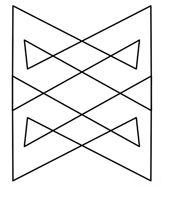
- a)0
- b)1
- c)2
- d)3
Correct answer is option 'C'. Can you explain this answer?
Identify the number of lines of symmetry for the figure given
.
.

a)
0
b)
1
c)
2
d)
3

|
Vp Classes answered |
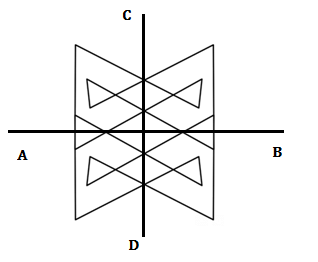
The above figure has two lines of symmetry. One is horizontal AB and another one is vertical CD.
Which of the lines in the picture are lines of symmetry of the figure?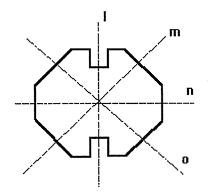
- a)l, m and o
- b)l and n
- c)l, m, n and o
- d)m and o
Correct answer is option 'B'. Can you explain this answer?
Which of the lines in the picture are lines of symmetry of the figure?
a)
l, m and o
b)
l and n
c)
l, m, n and o
d)
m and o

|
Get Idea answered |
If you can reflect (or flip) a figure over a lime and the figure appears unchanged, then the figure has reflection symmetry or line symmetry. The line that you reflect over is called the line of symmetry. A line of symmetry divides a figure into two mirror-image halves.
In the given figure, lines ll and nn divide figure into two mirror-image halves.
Hence, they are lines of symmetries.
In the given figure, lines ll and nn divide figure into two mirror-image halves.
Hence, they are lines of symmetries.
Find the number of lines of symmetry in a circle.- a)2
- b)3
- c)Many
- d)1
Correct answer is option 'C'. Can you explain this answer?
Find the number of lines of symmetry in a circle.
a)
2
b)
3
c)
Many
d)
1
|
|
Aniket Mukherjee answered |
Lines of Symmetry in a Circle
A line of symmetry is a line that divides a shape into two identical halves. A circle is a shape that is symmetrical all the way around, meaning that it has an infinite number of lines of symmetry. Here are some ways to understand why a circle has many lines of symmetry:
- Any line that passes through the center of a circle will divide it into two identical halves. Since there are an infinite number of lines that can pass through the center of a circle, there are an infinite number of lines of symmetry.
- A circle can be rotated by any degree and still look the same. For example, if you start with a circle and rotate it by 90 degrees, it will still look like a circle. This means that every degree of rotation creates a new line of symmetry.
- A circle can be reflected across any diameter (a line that passes through the center of a circle and touches two points on the circle) to create a line of symmetry.
Therefore, the correct answer is option C, "Many."
A line of symmetry is a line that divides a shape into two identical halves. A circle is a shape that is symmetrical all the way around, meaning that it has an infinite number of lines of symmetry. Here are some ways to understand why a circle has many lines of symmetry:
- Any line that passes through the center of a circle will divide it into two identical halves. Since there are an infinite number of lines that can pass through the center of a circle, there are an infinite number of lines of symmetry.
- A circle can be rotated by any degree and still look the same. For example, if you start with a circle and rotate it by 90 degrees, it will still look like a circle. This means that every degree of rotation creates a new line of symmetry.
- A circle can be reflected across any diameter (a line that passes through the center of a circle and touches two points on the circle) to create a line of symmetry.
Therefore, the correct answer is option C, "Many."
Determine the number of lines of symmetry for the following shape.

- a)0
- b)1
- c)2
- d)3
Correct answer is option 'A'. Can you explain this answer?
Determine the number of lines of symmetry for the following shape.


a)
0
b)
1
c)
2
d)
3

|
Moumita Desai answered |
The given figure does not have any line of symmetry.
Letter ‘G’ of the English alphabet have reflectional symmetry (i.e., symmetry related to mirror reflection) about.- a)a horizontal mirrorboth
- b)a vertical mirror
- c)both
- d)Neither horizontal nor veritcal
Correct answer is option 'D'. Can you explain this answer?
Letter ‘G’ of the English alphabet have reflectional symmetry (i.e., symmetry related to mirror reflection) about.
a)
a horizontal mirrorboth
b)
a vertical mirror
c)
both
d)
Neither horizontal nor veritcal
|
|
Nilotpal Nambiar answered |
Dear [Recipient],
I hope this letter finds you in good health and high spirits. I am writing to express my gratitude and appreciation for the opportunity to work with you on [project/event/task]. It has been an incredible experience and I wanted to take a moment to acknowledge your contribution and support.
From the very beginning, you have shown exceptional dedication and commitment to the project. Your expertise and insights have been invaluable in shaping our strategy and achieving our goals. Your ability to think creatively and problem-solve on the spot has been truly remarkable.
I also want to commend you on your leadership skills. Your ability to inspire and motivate the team has been instrumental in keeping everyone focused and engaged. Your open and approachable nature has created a positive and inclusive work environment, where everyone feels comfortable expressing their ideas and concerns.
Furthermore, your attention to detail and organizational skills have been instrumental in ensuring the smooth execution of our plans. Your ability to juggle multiple tasks and prioritize effectively has been an inspiration to all of us. Your professionalism and work ethic have set a high standard for the entire team.
I am truly grateful for the opportunity to work alongside someone as talented and dedicated as you. Your passion for excellence and commitment to delivering exceptional results have made a significant impact on the success of this project.
Once again, thank you for your invaluable contribution. I look forward to continuing our collaboration in the future and witnessing many more achievements together.
With sincere appreciation,
[Your Name]
I hope this letter finds you in good health and high spirits. I am writing to express my gratitude and appreciation for the opportunity to work with you on [project/event/task]. It has been an incredible experience and I wanted to take a moment to acknowledge your contribution and support.
From the very beginning, you have shown exceptional dedication and commitment to the project. Your expertise and insights have been invaluable in shaping our strategy and achieving our goals. Your ability to think creatively and problem-solve on the spot has been truly remarkable.
I also want to commend you on your leadership skills. Your ability to inspire and motivate the team has been instrumental in keeping everyone focused and engaged. Your open and approachable nature has created a positive and inclusive work environment, where everyone feels comfortable expressing their ideas and concerns.
Furthermore, your attention to detail and organizational skills have been instrumental in ensuring the smooth execution of our plans. Your ability to juggle multiple tasks and prioritize effectively has been an inspiration to all of us. Your professionalism and work ethic have set a high standard for the entire team.
I am truly grateful for the opportunity to work alongside someone as talented and dedicated as you. Your passion for excellence and commitment to delivering exceptional results have made a significant impact on the success of this project.
Once again, thank you for your invaluable contribution. I look forward to continuing our collaboration in the future and witnessing many more achievements together.
With sincere appreciation,
[Your Name]
Chapter doubts & questions for Symmetry - Mathematics & Pedagogy Paper 2 for CTET & TET Exams 2025 is part of CTET & State TET exam preparation. The chapters have been prepared according to the CTET & State TET exam syllabus. The Chapter doubts & questions, notes, tests & MCQs are made for CTET & State TET 2025 Exam. Find important definitions, questions, notes, meanings, examples, exercises, MCQs and online tests here.
Chapter doubts & questions of Symmetry - Mathematics & Pedagogy Paper 2 for CTET & TET Exams in English & Hindi are available as part of CTET & State TET exam.
Download more important topics, notes, lectures and mock test series for CTET & State TET Exam by signing up for free.
Mathematics & Pedagogy Paper 2 for CTET & TET Exams
82 videos|273 docs|69 tests
|

Contact Support
Our team is online on weekdays between 10 AM - 7 PM
Typical reply within 3 hours
|
Free Exam Preparation
at your Fingertips!
Access Free Study Material - Test Series, Structured Courses, Free Videos & Study Notes and Prepare for Your Exam With Ease

 Join the 10M+ students on EduRev
Join the 10M+ students on EduRev
|

|
Create your account for free
OR
Forgot Password
OR
Signup to see your scores
go up within 7 days!
Access 1000+ FREE Docs, Videos and Tests
Takes less than 10 seconds to signup

